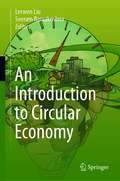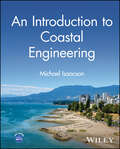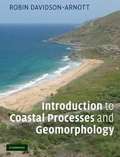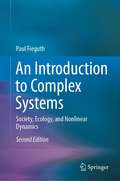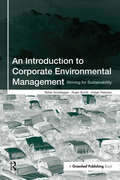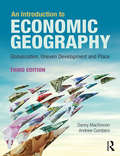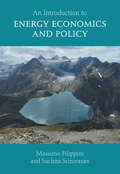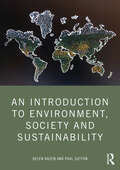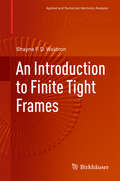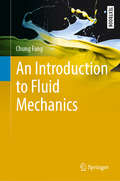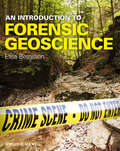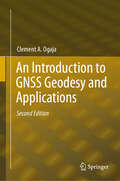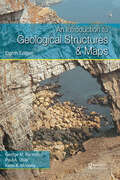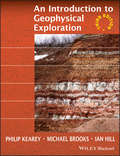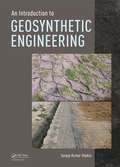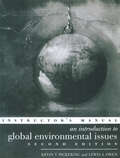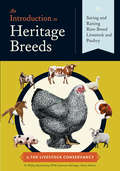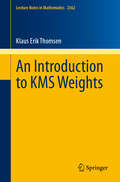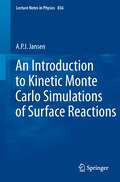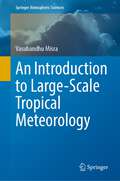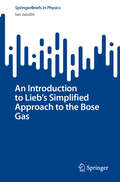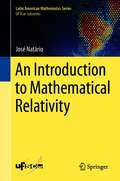- Table View
- List View
An Introduction to Atmospheric Thermodynamics
by Anastasios A. TsonisThis is a self-contained, concise, rigorous book introducing the reader to the basics of atmospheric thermodynamics, and the author is a highly respected researcher in this field. This new edition has been brought completely up to date and reorganized to improve the quality and flow of the material. Each chapter contains worked examples and student exercises, making this an ideal text for short undergraduate courses taken as part of an atmospheric science, meteorology, physics or natural science program. Solutions available to lecturers.
An Introduction to Circular Economy
by Seeram Ramakrishna Lerwen LiuThis book is purposefully styled as an introductory textbook on circular economy (CE) for the benefit of educators and students of universities. It provides comprehensive knowledge exemplified by practices from policy, education, R&D, innovation, design, production, waste management, business and financing around the world. The book covers sectors such as agriculture/food, packaging materials, build environment, textile, energy, and mobility to inspire the growth of circular business transformation. It aims to stimulate action among different stakeholders to drive CE transformation. It elaborates critical driving forces of CE including digital technologies; restorative innovations; business opportunities & sustainable business model; financing instruments, regulation & assessment and experiential education programs. It connects a CE transformation for reaching the SDGs2030 and highlights youth leadership and entrepreneurship at all levels in driving the sustainability transformation.
An Introduction to Coastal Engineering
by Michael IsaacsonUnderstand and respond to a changing coastline with this comprehensive reference Coastal engineering concerns society’s interactions with coastlines and relates, for example, to coastal flooding, beach erosion, seawalls and breakwaters, and the design of marinas. As climate change drives sea level rise, coastal engineering is critical in responding to increased coastal flooding and receding shorelines. The need to develop coastal infrastructure while minimizing environmental impacts makes this a vital field. An Introduction to Coastal Engineering offers a comprehensive overview of this subject, designed to bridge existing gaps in the general civil engineering literature. Covering all major aspects of coastal engineering, including ocean wave behaviour, structures, sediments, mixing processes, and modelling, the book emphasizes practical solutions and applications for students and practicing engineers alike. Thorough and rigorous, yet highly readable, the book is a must-own tool for developing solutions towards a sustainable coastal future. An Introduction to Coastal Engineering readers will also find: Pertinent descriptions of wave theories, wave transformations, and random wavesDetailed discussion of practical solutions, recent advancements in the field, and up-to-date data sourcesWorked-through examples and end-of-chapter problems with some written assignmentsA spreadsheet appendix containing a set of reference solutions An Introduction to Coastal Engineering is ideal for students in upper-level undergraduate and graduate courses in coastal engineering, practicing coastal engineers, and other engineers engaged in coastal flood protection, waterfront development projects, and the minimization of environmental impacts along shorelines.
An Introduction to Coastal Processes and Geomorphology
by Robin Davidson-ArnottWritten for undergraduate students studying coastal geomorphology, this is the complete guide to the processes at work on our coastlines and the features we see in coastal systems across the world. Accessible to students from a range of disciplines, the quantitative approach of this book helps to build a solid understanding of wave and current processes that shape coastlines. The resulting processes of erosion, transport and deposition and the features they create are clearly explained, with over 400 illustrations and photographs. From sandy beaches to coral reefs, the major coastal features are related to contemporary processes and to sea-level changes over the past 25,000 years. Key equations describing or predicting measurements from instruments used to map these processes are all presented in this wide-ranging overview. Davidson-Arnott completes this teaching package with online material that brings the subject to life, including videos of coastal processes and virtual field trips.
An Introduction to Complex Systems: Society, Ecology, and Nonlinear Dynamics
by Paul FieguthComplex Systems lie at the heart of a variety of large-scale phenomena of great significance - global warming, ice ages, water, poverty, pandemics - and this text uses these case studies as motivations and contexts to explore complex systems and related topics of nonlinear dynamics and power-law statistics. Although detailed mathematical descriptions of these topics can be challenging, the consequences of a system being nonlinear, power-law, or complex are in fact quite accessible. This book blends a tutorial approach to the mathematical aspects of complex systems together with a complementary narrative on the global/ecological/societal implications of such systems. Nearly all engineering undergraduate courses focus on mathematics and systems which are small scale, linear, and Gaussian. Unfortunately there is not a single large-scale ecological or social phenomenon that is scalar, linear, and Gaussian. This book offers insights to better understand the large-scale problems facing the world and to realize that these cannot be solved by a single, narrow academic field or perspective. Instead, the book seeks to emphasize understanding, concepts, and ideas, in a way that is mathematically rigorous, so that the concepts do not feel vague, but not so technical that the mathematics get in the way. The book is intended for students in technical domains such as engineering, computer science, physics, mathematics, and environmental studies. This second edition adds nine new examples, over 30 additional problems, 50 additional figures, and three new chapters offering a detailed study of system decoupling, extensive solutions to chapter problems, and a timely discussion on the complex systems challenges associated with COVID-19 and pandemics in general.
An Introduction to Corporate Environmental Management: Striving for Sustainability
by Stefan Schaltegger Roger Burritt Holger PetersenThis book is designed to meet the urgent need for a comprehensive and definitive introduction and teaching text on corporate environmental management. It aims to become the standard textbook for courses examining how business can take the environment into account while also providing an accessible and thorough overview of this increasingly multidisciplinary subject for practitioners.Written by the internationally acknowledged experts Stefan Schaltegger and Roger Burritt (authors of the highly influential Contemporary Environmental Accounting) along with Holger Petersen, the book invites the reader to join in an exploration of the ways in which companies can engage in environmental management and why such engagement can be profitable for business. The reader is invited to: examine whether the contents reflect their own experience, takes their experience further, or opposes their own views; note which of the ideas presented are especially important, add to those ideas, or encourage a reaction (positive or negative); answer questions creatively (based on their own perspective of the issues); encourage themselves to be inspired by questions, which can be investigated further through other written sources of information, such as books you will be guided to through the bibliography, the Internet or the general media; and think about and plan the ways in which the knowledge provided can be implemented in your own situation.The book is organised into four main sections. First, the fundamental ideas and linkages behind business management, the environment and sustainable development are briefly but clearly sketched. The second part of the book outlines the criteria against which environmentally oriented business management can be assessed and the fields of action in which success can be achieved. The third part presents a discussion and examples of strategies for environmental management, which are linked, in the fourth part, to the essential tools of environmental management, especially green marketing, environmental accounting and eco-control.The book is full of case studies and examples related to the main contents of each chapter and each chapter provides a number of questions for the student or reader to address.An Introduction to Corporate Environmental Management is both a textbook and a sourcebook. The reader can either work through the material in a structured way or dip into the content and follow up on specific areas of interest. The materials are designed to be used for understanding and reference, rather than to be learned by heart. The primary aim is for the reader to obtain a practical understanding of the relationship between management and environmental issues which can be applied in day-to-day situations-whether as part of a student's wider view of management or within the practitioner's real-world situation. It will be essential reading for many years to come.
An Introduction to Dynamic Meteorology
by James R. HoltonThis revised text presents a cogent explanation of the fundamentals of meteorology, and explains storm dynamics for weather-oriented meteorologists. It discusses climate dynamics and the implications posed for global change. Formulas have been removed.
An Introduction to Economic Geography: Globalisation, Uneven Development and Place
by Andrew Cumbers Danny MacKinnonIn the context of great economic turmoil and uncertainty, the emergent conflict between continued globalisation and growing economic nationalism means that a geographical economic perspective has never been so important. An Introduction to Economic Geography guides students through the key debates of this vibrant area, exploring the range of ideas and approaches that invigorate the wider discipline. This third edition includes new chapters on finance, cities and the digital economy, consumption and the environment. Underpinned by the themes of globalisation, uneven development and place, the text conveys the diversity of contemporary economic geography and explores the social and spatial effects of global economic restructuring. It combines a critical geographical perspective on the changing economic landscape with an appreciation of contemporary themes such as neoliberalism, financialisation, innovation and the growth of new technologies. An Introduction to Economic Geography is an essential textbook for undergraduate students taking courses in Economic Geography, Globalisation Studies and more broadly in Human Geography. It will also be of much interest to those in Planning, Business and Management Studies and Economics.
An Introduction to Energy Economics and Policy
by Massimo Filippini Suchita SrinivasanEnergy economics and policy are at the heart of current debates regarding climate change and the switch from fossil fuels to renewable forms of energy. They are also crucial in dealing with energy supply and security issues caused by global shocks such as the war in Ukraine. An Introduction to Energy Economics and Policy outlines pressing issues concerning current global energy systems, particularly energy production and use. It presents economic frameworks for valuating policy goals and for understanding the major energy and climate challenges faced by industrialized and developing countries. Integrating insights from behavioural economics into the standard neoclassical approach, particularly the role of behavioural anomalies, this book offers a novel introduction to energy economics and policy and provides a fresh perspective on real-world issues in energy and climate. This title is also available as open access on Cambridge Core.
An Introduction to Environment, Society and Sustainability
by Paul Sutton Helen HazenThis timely and innovative book delves into the complex interplay of human activities and natural limits in generating today’s sustainability challenges. By contrasting the pressures of growing populations with ecological footprints associated with consumption, the volume navigates the contested terrain where human societies generate environmental impacts.Adorned with illustrative figures, examples and case studies throughout, this book presents insightful analysis of ecological, economic, technological, and social justice responses to the challenges faced by human civilization, including land degradation, climate change, pollution, and overexploitation of natural resources. Many of these issues are wicked problems, characterized by incomplete information, multiple stakeholders, and contested approaches to addressing them. In simple terms, sustainability issues are an interplay between population growth and rising consumption, which are placing impossible demands on finite resources. Potential solutions to the crisis are split between green growth approaches that emphasize technology and institutional capacity to guide economic growth in more sustainable ways, and degrowth approaches that call for a fundamental rethinking of the way we structure society and generate value. This book emerged from a student seminar where undergraduate and graduate students highlighted sustainability topics of concern, helped consider their framing, and then assisted with co-writing several of the chapters. The volume encourages readers to consider structural questions that underpin sustainability dilemmas, and begins with four theoretical frameworks for understanding sustainability issues: ideas from the natural sciences, the population/consumption debate, economic frameworks, and ethical approaches. It then uses a systems approach to apply these theoretical ideas to complex global systems such as the atmosphere, oceans, and agriculture.This volume will be of pivotal interest to students, scholars and academics in the fields of environmental studies, environment and society, human geography and environmental geography, as well as those with an interest in these areas more generally.
An Introduction to Finite Tight Frames
by Shayne F. WaldronThis textbook is an introduction to the theory and applications of finite tight frames, an area that has developed rapidly in the last decade. Stimulating much of this growth are the applications of finite frames to diverse fields such as signal processing, quantum information theory, multivariate orthogonal polynomials, and remote sensing. Featuring exercises and MATLAB examples in each chapter, the book is well suited as a textbook for a graduate course or seminar involving finite frames. The self-contained, user-friendly presentation also makes the work useful as a self-study resource or reference for graduate students, instructors, researchers, and practitioners in pure and applied mathematics, engineering, mathematical physics, and signal processing.
An Introduction to Fluid Mechanics (Springer Textbooks in Earth Sciences, Geography and Environment)
by Chung FangThis textbook provides a concise introduction to the mathematical theory of fluid motion with the underlying physics. Different branches of fluid mechanics are developed from general to specific topics. At the end of each chapter carefully designed problems are assigned as homework, for which selected fully worked-out solutions are provided. This book can be used for self-study, as well as in conjunction with a course in fluid mechanics.
An Introduction to Forensic Geoscience
by Elisa BergslienAn Introduction to Forensic Geoscience provides fundamental training in geoscience as developed through the lens of its forensic applications. It incorporates a range of topics including geophysical methods of grave detection, the mineralogy of art, identification of microfossils, and comparison of soil trace evidence samples. Each topic is introduced using core concepts that are developed with increasing complexity in order to give readers an understanding of the underlying scientific principles involved and a taste of the wide range of possible forensic uses. A variety of detailed reference tables have been compiled for the text and each chapter contains lists of references to applicable textbooks and journal articles. Examples of real criminal cases are also presented in each chapter to make the connections between theory and real world application. The goal of this book is to give readers a familiarity with the wide range of ways in which geoscience principles and geological materials can be utilized forensically. Additional resources for this book can be found at: http://www.wiley.com/go/bergslien/forensicgeoscience.
An Introduction to GNSS Geodesy and Applications
by Clement A. OgajaThis volume is the second edition to 2022’s Introduction to GNSS Geodesy: Foundations of Precise Positioning Using Global Navigation Satellite Systems. It serves as an important reference to GNSS beginners as well as seasoned enthusiasts. In this updated edition, author Clement Ogaja focuses on fundamentals and contents that will remain unaffected by rapid changes and data exchange formats, ensuring that the book will remain up to date for years. The book consists of five chapters. The first covers basic concepts of parameter estimation in GNSS Geodesy. From there, Chapter 2 discusses reference systems in GNSS Geodesy. Chapter 3 moves on to observation models, errors, and biases, and Chapter 4, which is completely new to this second edition, details GNSS data processing workflow and strategies. The book concludes with an applied chapter that details concrete uses of GNSS Geodesy. New appendices that will be especially useful to seasoned users are also featured.
An Introduction to Geological Structures and Maps, Eighth Edition
by George M Bennison Paul A Olver Keith A MoseleyAn Introduction to Geological Structures and Maps is a concise and accessible textbook providing simple structural terminology and map problems which introduce geological structures. It is a perfect introduction to mapping for students of geology, engineering geology and civil engineering.Each topic is explained and illustrated by figures, and exercises follow on successive maps. If students are unable to complete an exercise, they can read on to obtain more specific instructions on how theory may be used to solve the problem. An appendix at the end of the book provides the solutions.This new, eighth edition contains simplified introductory matter to make the subject as easy to grasp as possible. Colour photographs illustrating geological structures bring the subject to life and a new map from the British Geological Survey illustrates a real area. There is more on outcrop patterns, which will help students to think in 3D, and on structures and the relationship of topography to geological structure. Cliff sections have been added to reinforce the concept of apparent dip. The section on planetary geology has been more closely tied to igneous geology to aid understanding of the connection between the two. Finally, a new map on economic geology has been added for the benefit of engineering students.A geological glossary helps students to understand and memorise key terms and a new, colourful, text design enlivens the appearance of this popular book.
An Introduction to Geophysical Exploration
by Michael Brooks Philip Kearey Ian HillThis new edition of the well-established Kearey and Brooks text is fully updated to reflect the important developments in geophysical methods since the production of the previous edition. The broad scope of previous editions is maintained, with even greater clarity of explanations from the revised text and extensively revised figures. Each of the major geophysical methods is treated systematically developing the theory behind the method and detailing the instrumentation, field data acquisition techniques, data processing and interpretation methods. The practical application of each method to such diverse exploration applications as petroleum, groundwater, engineering, environmental and forensic is shown by case histories. The mathematics required in order to understand the text is purposely kept to a minimum, so the book is suitable for courses taken in geophysics by all undergraduate students. It will also be of use to postgraduate students who might wish to include geophysics in their studies and to all professional geologists who wish to discover the breadth of the subject in connection with their own work.
An Introduction to Geosynthetic Engineering
by Sanjay Kumar ShuklaThe development of the use of polymeric materials in the form of geosynthetics has brought about major changes in the civil engineering industry. Geosynthetics are available in a wide range of compositions appropriate to different applications and environments. Over the past three to four decades, civil engineers have grown increasingly interested
An Introduction to Global Environmental Issues Instructors Manual
by Lewis A. Owen Professor Kevin PickeringAn Introduction to Global Environmental Issues presents a comprehensive stimulating introduction to the key environmental issues presently threatening our global environment. Offering an authoritative introduction to the key topics, a source of latest environmental information, and an innovative stimulus for debate, this is an essential book for all those studying or concerned with global environmental issues.In this second edition, the most topical global environmental issues are brought more clearly into focus. Explanations of the evolution of the earth's natural systems (hydrosphere, biosphere, geosphere, ecosphere) provide the essential understanding of the scientific concepts, processes and historical background behind key environmental issues. Contemporary socio-economic, cultural and political considerations are explored and important conceptual approaches such as Gaian hypotheses and Chaos Theory are introduced. Human impact and management of the natural environment, and concerns for maintaining biodiversity are emphasised throughout.Specific features include: Case studies drawn from across the world Superb illustrations: 4-colour plate sections; a wealth of informative diagrams Glossary of key terms, with key concepts highlighted throughout the text Annotated guides to Further Reading Chapter summaries and key points A new Instructors' Manual is available to accompany the text
An Introduction to Heritage Breeds: Saving and Raising Rare-Breed Livestock and Poultry
by Alison Martin D. Phillip Sponenberg DVM Jeannette BerangerDeveloped for the particular needs of the working farm, heritage breeds have proved invaluable to small-scale agricultural production for centuries. This comprehensive guide explains why conserving heritage breeds remains important and how they often can be a better choice for the modern farmer than conventional animals. With profiles of heritage poultry, sheep, cattle, and more, you’ll learn how to select and successfully raise the breed that is right for your specific needs. Enjoy the benefits of resilient livestock while preserving genetic diversity for future generations.
An Introduction to Humanitarian Action (Routledge Humanitarian Studies)
by Kristina Roepstorff Katrin RadtkeThis important new textbook provides a concise and practice-oriented introduction to the workings of the humanitarian sector and the key contemporary debates surrounding it.The number of people around the world in need of humanitarian action and protection is at its highest figure in decades; yet at the same time, the humanitarian system is facing numerous problems and undergoing fundamental reforms. This book invites us to tackle these challenges head on, addressing the increasing complexity of humanitarian crises and the implications for humanitarian principles and standards as well as the management of humanitarian projects. Expansive in scope, the book covers: The sector’s historical foundations and the need to decolonise The main types of crises and sectors of humanitarian response State and non-state actors and institutions The key rules, norms, and project management approaches Key trends and challenges, including access, innovation, and anticipation The book also covers important debates on localisation, inclusive programming, and the decolonisation of the humanitarian system. This exciting new textbook will be an important read for students looking for a comprehensive introduction, as well as for practitioners wanting to stimulate critical thinking and enhance their practical skills.
An Introduction to KMS Weights (Lecture Notes in Mathematics #2362)
by Klaus Erik ThomsenThis book provides an introduction to the theory of KMS weights and KMS states, which play an important role in mathematical physics and other applications of operator algebras. Leading from the definitions to some of the most recent research results, it covers advanced topics such as the Laca-Neshveyev theorem, elements of the modular theory of von Neumann algebras, the geometry of the set of KMS weights, duality (for KMS weights on crossed products), the relationship between KMS weights and traces and the types of factors associated with extremal KMS weights. Some of the material is new, in the sense that the proofs and results are published here for the first time. This relatively self-contained book will be useful both to researchers in the area of operator algebras and to more advanced students who wish to enter this field.
An Introduction to Kinetic Monte Carlo Simulations of Surface Reactions (Lecture Notes in Physics #856)
by A.P.J. JansenKinetic Monte Carlo (kMC) simulations still represent a quite new area of research, with a rapidly growing number of publications. Broadly speaking, kMC can be applied to any system describable as a set of minima of a potential-energy surface, the evolution of which will then be regarded as hops from one minimum to a neighboring one. The hops in kMC are modeled as stochastic processes and the algorithms use random numbers to determine at which times the hops occur and to which neighboring minimum they go. Sometimes this approach is also called dynamic MC or Stochastic Simulation Algorithm, in particular when it is applied to solving macroscopic rate equations. This book has two objectives. First, it is a primer on the kMC method (predominantly using the lattice-gas model) and thus much of the book will also be useful for applications other than to surface reactions. Second, it is intended to teach the reader what can be learned from kMC simulations of surface reaction kinetics. With these goals in mind, the present text is conceived as a self-contained introduction for students and non-specialist researchers alike who are interested in entering the field and learning about the topic from scratch.
An Introduction to Large-Scale Tropical Meteorology (Springer Atmospheric Sciences)
by Vasubandhu MisraThis upper-undergraduate/graduate-level textbook introduces students to large-scale tropical climate circulation and its variations, covering their fundamental aspects and our current understanding of how they are impacted in a warming world. From this volume, readers will gain an understanding of tropical climate variability from the meso- to planetary scale. Uniquely, equal emphasis is placed on atmospheric and oceanic processes of tropical phenomena. The book will appeal to senior undergraduate and graduate students across geoscience disciplines, including in meteorology, oceanography, geography, hydrology, and environmental science.
An Introduction to Lieb's Simplified Approach to the Bose Gas (SpringerBriefs in Physics)
by Ian JauslinThis book explores Lieb's Simplified approach to the ground state of systems of interacting bosons. While extensive research has delved into the behavior of interacting bosons, persistent challenges, such as proving Bose-Einstein condensation, remain. Introduced by Lieb in 1963, the Simplified approach has been the object of renewed attention in recent years, revealing surprising and promising results. Notably, this approach provides ground state energy predictions that agree with many-body systems asymptotically at both low and high densities. It further predicts a condensate fraction and correlation function that agree with Bogolyubov theory at low densities, and numerical predictions match quantum Monte Carlo simulations across all densities. This suggests that Lieb's Simplified approach could serve as a potent tool for reimagining the study of interacting bosons. The book defines Lieb's Simplified approach, discusses its predictions, and presents known analytical and numerical results. It is designed for advanced students and young researchers working in the fields of mathematical physics, quantum many-body physics and Bose-Einstein condensates.
An Introduction to Mathematical Relativity (Latin American Mathematics Series)
by José NatárioThis concise textbook introduces the reader to advanced mathematical aspects of general relativity, covering topics like Penrose diagrams, causality theory, singularity theorems, the Cauchy problem for the Einstein equations, the positive mass theorem, and the laws of black hole thermodynamics. It emerged from lecture notes originally conceived for a one-semester course in Mathematical Relativity which has been taught at the Instituto Superior Técnico (University of Lisbon, Portugal) since 2010 to Masters and Doctorate students in Mathematics and Physics. Mostly self-contained, and mathematically rigorous, this book can be appealing to graduate students in Mathematics or Physics seeking specialization in general relativity, geometry or partial differential equations. Prerequisites include proficiency in differential geometry and the basic principles of relativity. Readers who are familiar with special relativity and have taken a course either in Riemannian geometry (for students of Mathematics) or in general relativity (for those in Physics) can benefit from this book.

